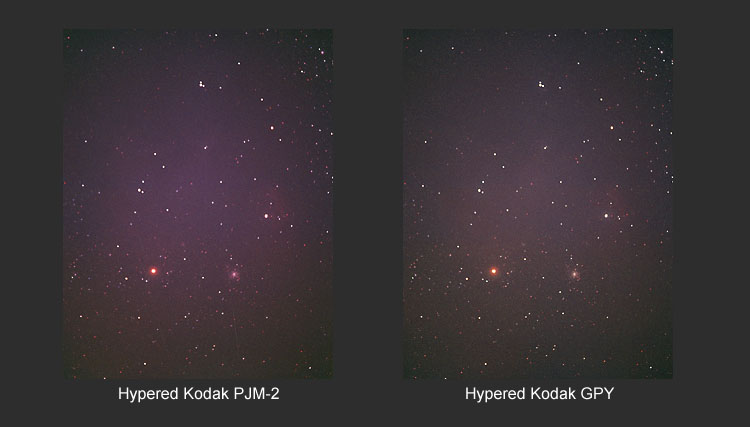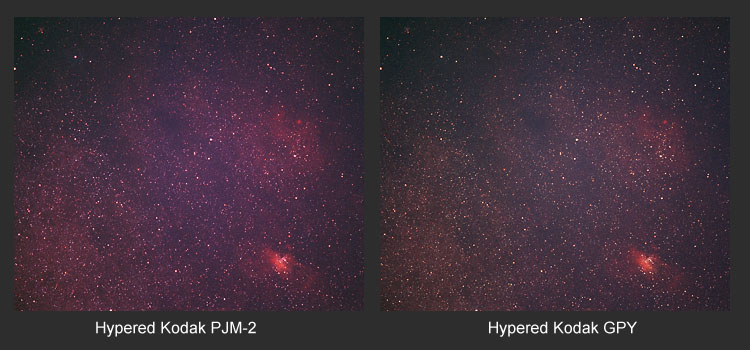
This is a comparison of two films that are widely used for astrophotography:
Film Nomenclature:Owing to the 'grey import' problem some films have different nomenclature in the UK than in the US. PJM-2 is the same, however the film known in the US as PPF-2 is not available in the UK. According to Kodak's Professional Products Division in Hemel Hempstead, UK, GPY is exactly similar to PPF-2 - this was stated on two occasions by separate members of their staff. Whether or not there are subtle differences in fabrication, I cannot tell. However it seems unlikely that Kodak would incur the overhead of changing the manufacturing specification in different markets for no apparent gain. In these comparisons, unless informed otherwise, I shall assume that GPY = PPF-2.
PJM-2 Debate: PJM-2 must be the most controversial film ever used
for astrophotography. Reports of its performance for astrophotography vary so
widely that sometimes it is difficult to believe that the same film is being
used. Some users report that it has virtually no blue response, others report
that it has very low contrast, while others report that it is the best film
they have ever used for astrophotography. Somewhere within all of this lies
the real answer. That is what prompted this comparison. I am sure that
this comparison is not good enough to provide the definitive answer, but hopefully
it takes us nearer the truth.
Caveat:This is a "warts and all" test - all three comparative
exposures are presented, even though in two of them the lens was not even focused,
and in another little more than sky fog is recorded.
Exposure Notes - All Images:
A fast lens was chosen so that exposure times could be kept short. I tried to
select an area of sky with both emission and reflection nebulosity. This is
hard to do from the UK in May, owing to very low elevation of the summer Milky
Way.
Image Processing Notes - All Images:
Meticulous care was taken to ensure that both images were processed in identical
fashion. The negatives were scanned at 1350 dpi using the Polaroid SprintScan
35 Plus. A moderate contrast stretch was performed in the scanner software (exactly
similar for both). To calibrate the scans, a dark neutral spot was chosen, located
about one-quarter of the image width from the left side in the top left quadrant.
The exact same spot was used in both images.
Repeated scans were opened in Photoshop, and the calibration spot was inspected with the eyedropper tool, 5x5 average. Repeated adjustments were made using the scanner Exposure function, until the RGB levels were the same, plus or minus 1 unit. This was repeated with the second image, until the RGB levels were as close as possible to the first image. Some strong colour differences can be seen in the central region of the photos, however this is part of the comparison, and is the reason why the calibration spot was purposely chosen to be a dark neutral spot towards the edge.
In Photoshop, the images were cropped to exactly similar size, re-scaled to display resolution, and sharpened with Unsharp Mask (exactly similar settings). The images were pasted onto the grey background and finally cropped. No actual image processing was done in Photoshop.
Conclusion:
No conclusions are drawn from this comparison
- the idea is only to present images to enable the reader to decide if there is
any difference between the two films, and if so, which one might perform better
for astrophotography. However, the following observations are pertinent:
Question: I do not fully understand why both of these lenses should exhibit such strong vignetting. These lenses are of very high specification: Nikon 400mm f/3.5 (about 8 years old) and Nikon 300mm f/2.8 (about 6 years old). They are both in mint+ condition and are optically untouched. The 300mm especially, is of very recent design (it has the beige "cabin trunk" style of case). Optical performance of both lenses (apart from the vignetting) is superb. I would appreciate hearing from anyone who can shed any light on this.

Notes:
Lens not focused!! Conditions were quite good for the UK - transparency
7, seeing 5. Ideally I would have photographed the Veil Nebula, but it did not
rise high enough above local rooftops by the time dawn light encroached. The
GPY photo appears to have a green cast, however the sky background was accurately
set to black at the calibration spot (off the left edge due to cropping).

Notes:
Lens not focused!! Record of UK sky fog! (object elevation only 12 degrees)
However by careful inspection some differences may be seen in the recording power
of the two films. Conditions were excellent for the UK - transparency 7, seeing
7.

Notes:
I finally learnt how to focus! However the PJM-2 shot is very slightly trailed.
The very bright nebulous region toward the lower right is M16. This image does
include one small very faint area of reflection nebulosity: IC1287, which surrounds
the brightest star in the dark area of the upper left quadrant (not the star
on the left edge). By very careful inspection, a small blue ellipse may be seen
encircling this star (if you do not see it in one photo, inspect the other).
Conditions were excellent for the UK - transparency 7, seeing 7.
|
|
|
|